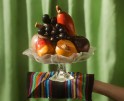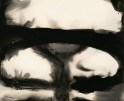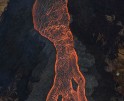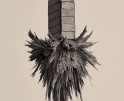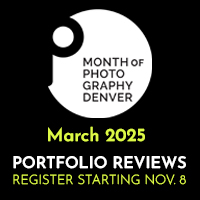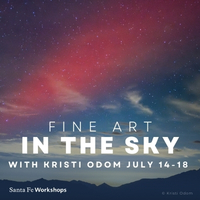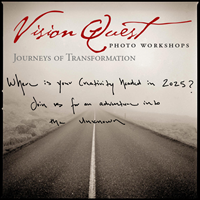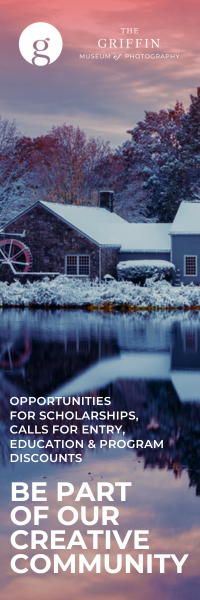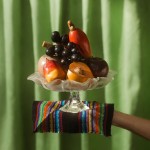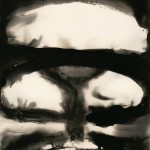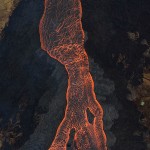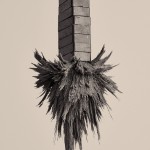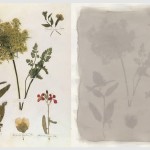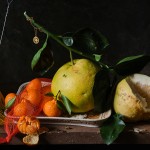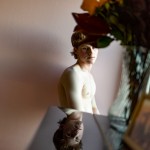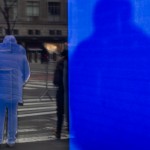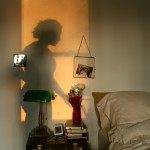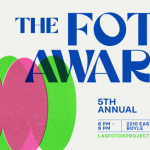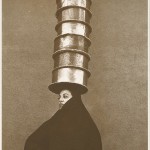2022 Hearst Journalism Awards: Chasity Maynard: 2022 Finalist Photo Championship
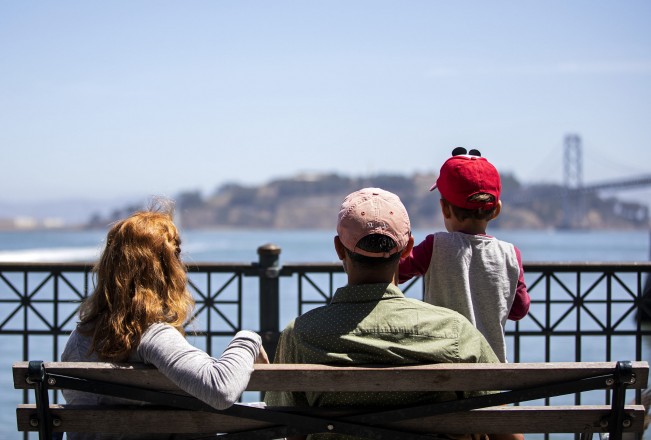
©Chasity Maynard, Rubin Sidhu and Jenny Mullins moved to San Francisco years ago. The couple sits with their 2-year-old son, Tej Mullins, and look out over the water at the San Francisco Bay on Sunday, May 22, 2022. This essay follows three groups of people, from a local family, Californians, and from Germany, to see why they are attracted to California.
This week we are celebrating photographers who have received a 2022 Hearst National Championship Award. Today we focus on National Photojournalism Championship 2022 Finalist in Photo, Chasity Maynard, from University of Florida who received a $1500 scholarship and Hearst Medallion. The Story Promp was Individual expression and the Californian Dream.
The Hearst Championships are the culmination of the 2021 – 2022 Journalism Awards Program, which were held in 103 member universities of the Association of Schools of Journalism and Mass Communication with accredited undergraduate journalism programs. From May 20 – 25, 2022, 29 finalists – winners from the 14 monthly competitions – participated in the 62nd annual Hearst Championships in San Francisco where they demonstrated their writing, photography, audio, television and multimedia skills in spot assignments. The assignments were chosen by media professionals who judged the finalists’ work throughout the year and at the Championships.
Chasity Maynard is a photojournalist and reporter. She placed second in the 2021 Hearst Journalism Awards Photojournalism Features and News Competition and will compete in the semi-finals round this April. She also received the 2021-2022 Haviland Photojournalism Scholarship.
Chas will graduate from the University of Florida in April with a specialization in photojournalism. Her photography career took off instantly. She is currently a photographer and visual journalist for Fresh Take Florida, a capstone journalism program and news wire service at the University of Florida. In the past she has worked at the Orlando Sentinel, The Gainesville Sun, WUFT News, The Independent Florida Alligator and Atrium magazine in a variety of roles including as a photographer, intern, editor, beat reporter and researcher.
Chas has demonstrated a passion for storytelling since she was a child. She started pursuing journalism after joining her high school newspaper staff. In her free time, Chas enjoys reading, listening to music and singing. She loves to spend time hiking and exploring new places. You can usually find her sipping something caffeinated and waiting for an opportunity to tell a pun.
Follow Chasity Maynard on Instagram: @chasitymaynardphoto
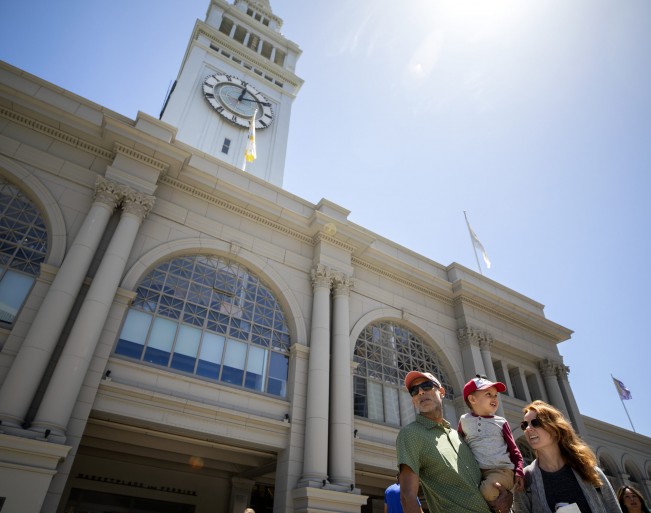
©Chasity Maynard, Rubin Sidhu and Jenny Mullins moved to San Francisco years ago. The couple leave the Ferry Building with their 2-year-old son, Tej Mullins, at the San Francisco Bay on Sunday, May 22, 2022.
Story Summary
This essay follows three families who were sight-seeing in and around San Francisco: a local family from San Francisco, a group from California, and a group from Germany, to see why they are attracted to California.
I was very focused on the writing part, and I was probably doing my math homework during the photography lessons in that class. I felt like very confused by a lot of it. Then, in college, I was planning to minor in Spanish, and then in spring of 2020 my Spanish study abroad for that summer got canceled because of the pandemic and that study abroad being cancelled put me behind on the Spanish minor and I decided to drop it because it would be really difficult to stay on pace, without that for graduation and I didn’t want to all that work.
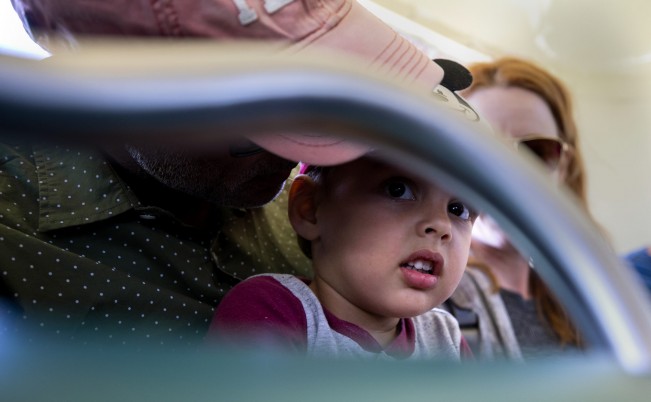
©Chasity Maynard, Rubin Sidhu speaks leans in to talk to his 2-year-old son, Tej Mullins, as the family rides a rail car away from the San Francisco Bay on Sunday, May 22, 2022.
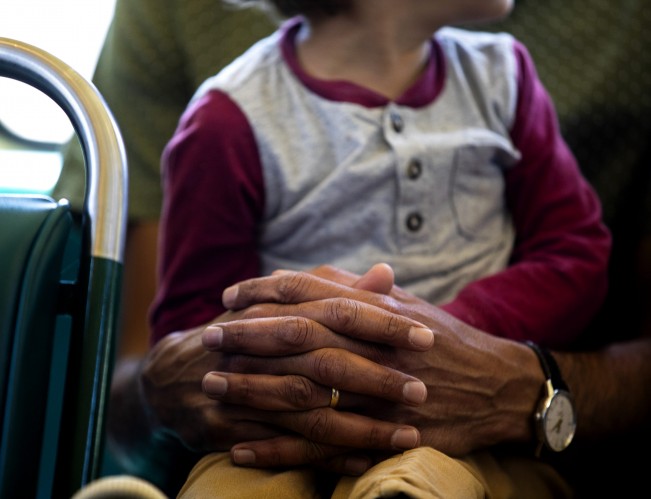
©Chasity Maynard, Rubin Sidhu crosses his hands as his 2-year-old son, Tej Mullins, sits on his lap while the family rides a rail car away from the San Francisco Bay on Sunday, May 22, 2022.
Judy Walgren: Thank you for hopping on a Zoom with me! I know you are busy. I’d like to start with a bit of background like where you are from and how you found photography?
Chasity Maynard: I graduated from the University of Florida this past spring and, at the end of April and I just started a job at the Tallahassee Democrat. I’m from Polk County, Florida, and went to high school in Orlando. I got into photography because I some background in it from my high school newspaper. They taught fundamentals and honestly, in high school, I didn’t like it! I thought I was bad at it and that was basically my only reason to not like it.
So I had extra room in my schedule and I was like, “Well, I’ll take a photography class because it will make me a much more competitive reporter.”
And then I was kind of juggling photography and writing and my writing professors for telling me or waste your time with photography to be a writer and my photography professors were telling me, “Chas, you have to pick one because you need to go all in on it—you’re good at it.” (Which was very nice of them.) And so I decided that before the next summer I was going to do photography or writing based on like what internships I got. I was just going to let fate decide my destiny. And I got a photography internship that summer at the Gainesville Sun and then that Fall, I got an internship at the Orlando Sentinel. And then I was offered an internship in South Florida, but I ended up canceling it because I got offered a full time job here in Tallahassee. So it’s kind of been a wild ride because I didn’t even start taking photos until my junior year and I didn’t start really taking it seriously until the end of my junior year. And the summer before my senior year is when I had my first photo internship. It was a whirlwind after that.
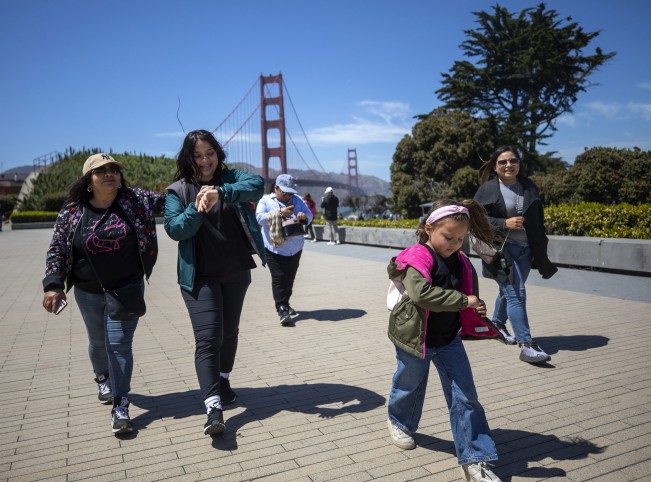
©Chasity Maynard, Aubrey Smith, 5, leads her family to the gift shop at the Golden Gate Bridge on Saturday, May 21, 2022 in San Francisco, California. The family traveled from Los Angeles because to be somewhere new that still feels like home.
Judy: Well, you must be super talented!
Chasity: Especially during the pandemic, it made me realize that my favorite part about writing and about storytelling was connecting with people. And I feel like the camera gives me an opportunity to do that in a way that I couldn’t, especially during the pandemic as a writer and just in general. I think my strongest qualities as a writer or my ability to put people in a scene and describe the situation and really help people understand the details or the sensations of whatever’s going on in the story, and I think that translates into visuals, as well.
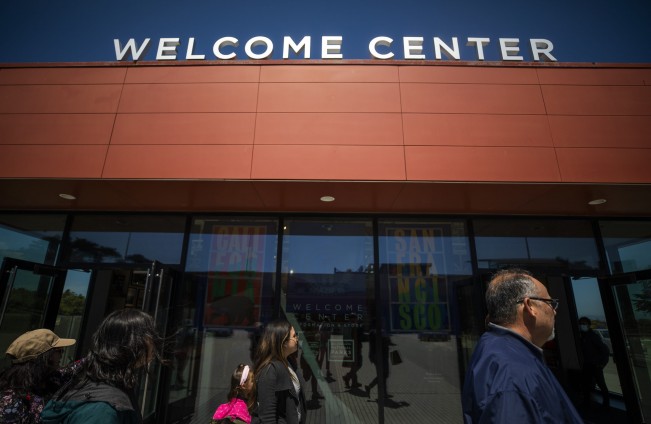
©Chasity Maynard, The Smiths and Beñas walk past the Welcome Center at the Golden Gate Bridge on Saturday, May 20, 2022 in San Francisco, California.
Judy: I wholeheartedly agree with you! I also found that photography gave people less points to argue with than writing.
So that leads to my next question – what area of photojournalism are you the most attracted to or you attracted to the diversity of areas that you can explore through it?
Chasity: That’s a good question. I totally agree with you, I like that about photography, as well—just to touch on that. There’s less to argue it and there’s less chance of what I’m saying to be perceived as subjective or having a narrative. That was better for my mental health. I found that photography was a way for me to tell stories and not be so anxious about having a fact error, or about will someone see this and thinking that i’m trying to support right wing media or think I’m a crazy liberal. I still deal with that, especially in Florida, but it gave me a bit of a breath from that—a step back from that intensity that comes with being a writer—which I have a lot of respect for, but it was really hard for me to manage, especially as a young reporter with mental health issues and the pandemic. It was really taking a toll on me. That being said, I really love feature photography. I like covering women and children and people who are often left out of “normal” storytelling.
I enjoy everything and right now I’m trying to get more into sports. I want to learn more about that, because I think that it challenges me the most, because it’s so exciting and makes my brain work in a different way than normal. But feature photography and those stories around lesser covered communities are my favorite.
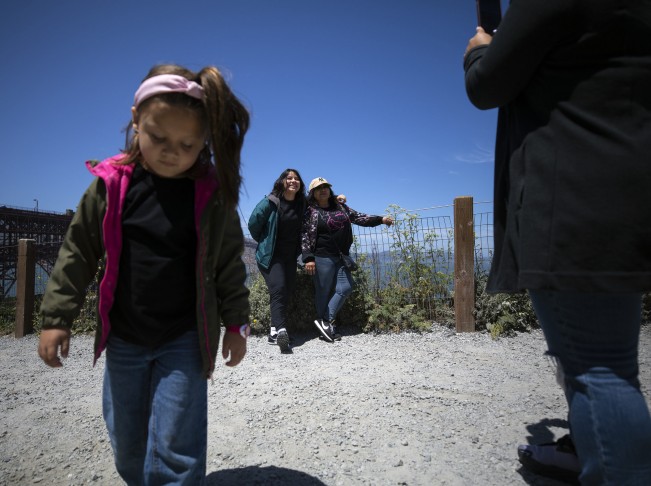
©Chasity Maynard, Aubrey Smith, 5, walks away as her relatives Karla and Vicky Beña pose for a photo by the Golden Gate Bridge on Saturday, May 20, 2022 in San Francisco, California.
Judy: Great answer. Thanks. So, let’s move on to Hearst. What was the story prompt, as you saw it, and then, can you talk about how you found your story, and then tell us a bit about it?
Chasity: So how I interpreted the story prompt was, “How does San Francisco embody the California dream?” When I first read that I was at first trying to go deep—like the California dream doesn’t really exist. My idea was to cover nursing homes and people who have survived the pandemic but are very really struggling to survive and they’re in this vibrant city and can’t even really experienced it. But the first thing when I got there, the judges explained that they wanted it to be a happy prompt and they weren’t trying to be like that the California dream doesn’t exist. So, I was like, “Okay, maybe I was being a little bit too pessimistic. Let me rethink this. Saturday, my first day out and about, I was walking around trying to figure out what I was going to do and struggling. It was a hard day for me, personally, because it was my grandmother’s birthday and she raised me and she died when I was 17. She got cancer and died within six months of her diagnosis. And so I called my dad and he was also not having a good day and it was kind of funny because the morning of my first day in San Francisco, I sat by the bay on the phone with my dad and we were just both crying. I was so excited to be here, but today is a day that more than any day, I want to be like with my family and with people I love.
I felt so alone and overwhelmed and stressed in this big city and I started thinking about a story that would make the experience meaningful to me and a story that I felt would matter to my grandmother. It made me think about how the California Dream, to me, is about being prosperous and having family and being able to experience things with them. And so, I thought, “Why don’t I capture families in the city—falling in love with it. Isn’t that the California dream—that these people want to come here to find hope; to have these moments with each other?” And then I selfishly thought, “I don’t have to be alone, this whole time.” I really didn’t want to be walking around the city every day alone with a more intense story that was going to make me kind of feel bad and stress. I thought it was something that would be comforting to me when I was kind of having a hard time personally—completely unrelated to the story. I thought it was something that my grandmother would be proud of and would be something that she would want to read. And I thought it’d be something that would help people, because when you’re on vacation with your family, it’s hard to capture those special moments together.
So, the first day I decided to the Golden Gate Bridge to see if I could find a family there to let me follow them around. And then Ill see if they will keep letting me follow them around. I got a lot of no’s and then a family finally said yes to me. They walked around. they hiked for a while. They went shopping in the gift shop there. They got some drinks at a little coffee place by the bridge. But after that, they said they’re going to dinner, and I wasn’t invited.
I was pretty like tired and hungry at that point, so I just went back to the hotel. I felt like pretty glad that things went well with them.
They were from California, but not from San Francisco, so I thought that could be interesting.
And then the next day I went to the place by the water—the Ferry Building and that one was rough. I was walking around for a very long time, and everybody was saying no—that they didn’t have time. I was getting ready to leave and then one of the families that said no to me—the mom walked up and said, “Actually, you can come and take pictures of us for a little bit but we’re just going to go sit outside and eat, though.” I was so relieved, and I was so surprised that she went and found me. She said that her good friend is a photographer and so she felt for me.
I think that might have been like my favorite time and because it was so simple and I love the intimacy of that moment. It was just a mother, father and their little boy. They just went and sat by the water behind the Ferry Building and had a little bit of breakfast. They were all three of them sitting on a bench. It was just a really cute and sweet simple moment.
They were actually from San Francisco, so I felt like my story with starting to shape up with like different levels of intimacy with the city. So I was hoping to find someone who was from another state, or a different country as a full like zoom out experience.
So, I followed them around and then they let me take the train with them for a bit. They weren’t taking the train anywhere; they are just taking it because their son really liked it. And after a few stops, we parted ways.
Then the last family I met at Lombard Street. It was kind of the same thing—I had been asking people for a long time and everyone was saying no. It was super-hot that day and I had to go find shade and sit down and put my head down, because I was feeling sick from walking around so much with no luck. And then I got a family to say yes! And this family was from Germany!
I had been really like consciously trying to be representative in my photos. I didn’t want to just have a bunch of photos of white people. I was very consciously trying to think about that, and like think about the people that I was actually seeing and to represent the diversity of the city. and so I was excited to have another family say yes to me and represent a different culture and ethnicity.
I followed them around Lombard Street and then we walked all the way down through little Italy and into Chinatown. This family probably would have let me go with them for longer, but I actually had to leave behind one of our like fancy dinner things that night, and I was going to be late if I didn’t go.
Those photos from that night embarrassing because I did not have time to wash my hair before I went to that dinner. And then I ended up sticking with those three families. I went to a couple other places like the Fisherman’s Wharf and didn’t really have any luck.
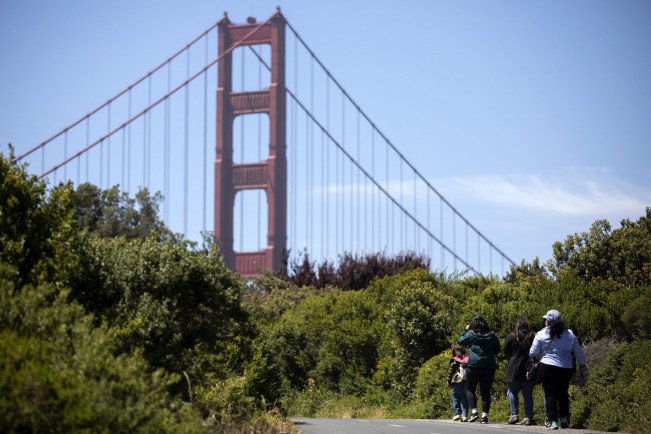
©Chasity Maynard, Aubrey Smith, 5, leads her family to the Golden Gate Bridge on Saturday, May 20, 2022 in San Francisco, California. The family traveled from Los Angeles because to be somewhere new that still feels like home.
Judy: That’s a lot that! Your story idea is really interesting. So overall—what are your takeaways that you’d like to share?
Chasity: I think probably the biggest thing for me is before I even got there, I was struggling with, “This is a mistake—I don’t belong here,” when I did.
When I first arrived at that big fancy hotel and meeting these incredible judges and my fellow competitors, I just was really struggling with my confidence. I really felt like, “I don’t belong here. I don’t understand how I got here,” and my biggest takeaway is that I did belong there and I need to have more confidence in myself. Even if I felt like my approach was different than some other people’s, it doesn’t mean that I am not supposed to be there.
I think my biggest takeaway was accepting that I really did make it there, even if it doesn’t feel like I should be there, but I am. And to be confident in myself that I made it there from my own work, and I deserve to be there, and it wasn’t a mistake. That I and my work and my stories and the way I care about people is why I should be there.
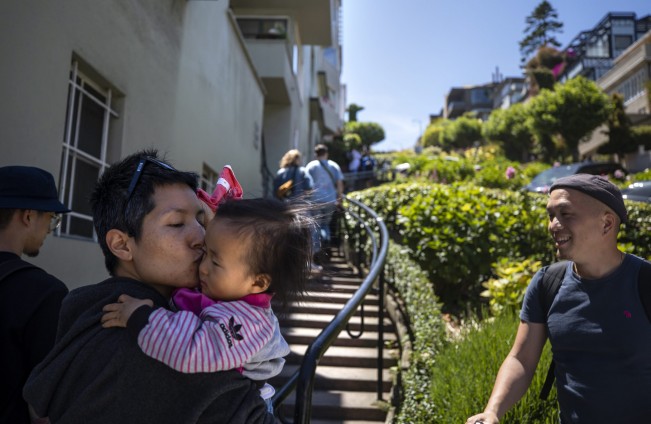
©Chasity Maynard, Mai-Lan Moua, from Germany, kisses her 18-month-old daughter Maxine Moua as her husband Pheng Ty watches on Sunday, May 22, 2022 in San Francisco, California.
Judy: Thank you for sharing. Who are some of the photographers who have shaped your style or your approach to your work?
Chasity: I think that Tom Brenner is someone whose work I look at for a lot of inspiration on how to look at things more creatively and I feel like every single time I see a photo from him, I am just like, “How do you see that!”
My professors Daron Dean and Rick Shaw have also had a really tremendous influence on my work and my style and my ambition. Daron has been like a personal mentor to me. I thought of myself as a writer, and he didn’t pressure me, but just really encouraged me. I remember that at the beginning of his class, he asked, “What do you want? What’s the main thing you want to get out of this class?” And my thing was I just wanted to be confident in my work and that I could do this. I feel like he has been one of my biggest cheerleaders and he loaned me his personal photography equipment to take to San Francisco because my collection is still pretty small. He has just been so supportive and encouraging.
And then for my Professor Shaw—he always tells his students to put on their wacky hats and get the safe shots; get the important things that you need—our storytelling images, but then get weird—find some strange angle, find a reflection with cool light.
I feel like I think about that every single day, every moment I’m taking a photo I’m trying to think about like where’s my wacky hat photo? He is such a strong editor. We had a lot of quality time together and it gave me the opportunity to sit down with him every week and go through my full take and get his feedback on it. He’s so talented.
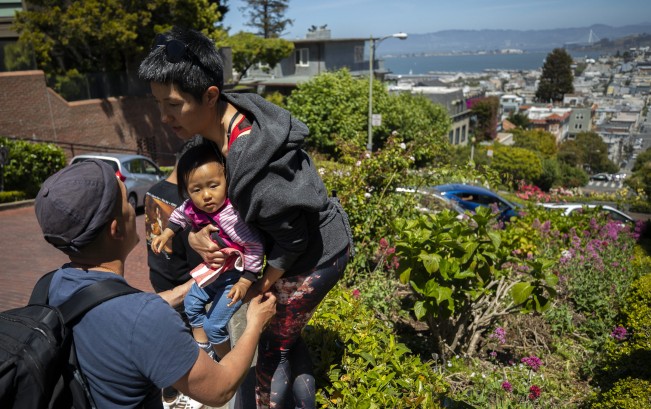
©Chasity Maynard, Mai-Lan Moua, from Germany, passes her 18-month-old daughter Maxine Moua to her husband Pheng Ty on Lombard Street on Sunday, May 22, 2022 in San Francisco, California.
Judy: Is there any advice you’d give someone who’s thinking about dabbling into photojournalism or anything you wish you had known?
Chasity: Definitely, I think the biggest thing I would say is don’t let yourself get intimidated by everyone else, I think there’s a culture in journalism and especially in photojournalism to
try to be very tough. Everybody struggles with their images at times, and everybody is affected by some of their stories, whether or not they want to admit it.
Judy: I am so glad you are a photojournalist. You deserve it.
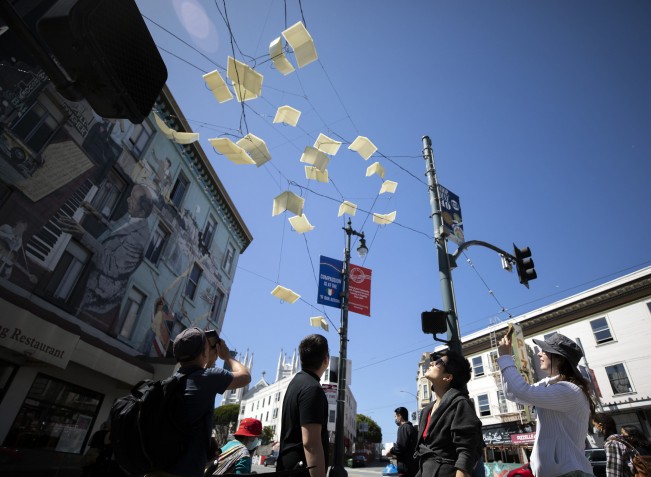
©Chasity Maynard,Mai-Lan Moua, from Germany, and her 18-month-old daughter Maxine Moua and family walk through Little Italy on Sunday, May 22, 2022 in San Francisco, California.
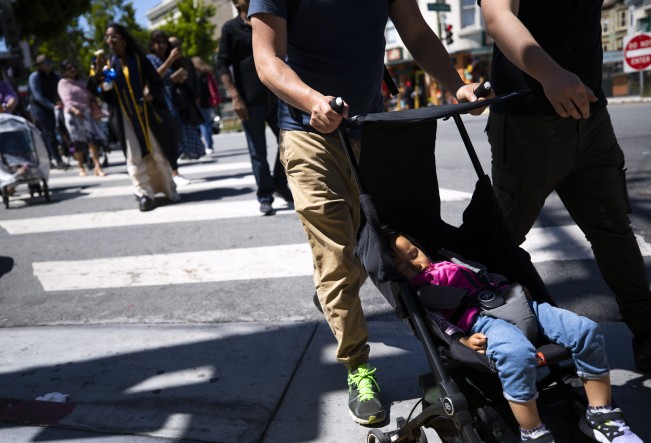
©Chastty Maynard, Maxine Moua, an 18-month-old Germany native, sleeps as her father pushes her stroller on Sunday, May 22, 2022 in San Francisco, California.
MSU J-School Associate Director and Professor of Practice Judy Walgren is an award-winning photographic artist, teacher, photo editor, curator and writer. received her MFA in Visual Art from the Vermont College of Fine Art in January 2016 where she began her exploration into the disruption of historic visual archives. From 2010 to 2015, she was the Director of Photography at the San Francisco Chronicle, where she managed a staff of visual content producers, photo editors and pre-press imagers for print and digital platforms. During her tenure at the Chronicle, her team won multiple Emmy Awards for their multimedia pieces and they earned Photo Editing Team of the Year from Best of Photojournalism. She has also worked for the Denver Post, The Rocky Mountain News and the Dallas Morning News. Walgren received a Pulitzer Prize for International Reporting with a team from the Morning New for their series dealing with violent human rights against women. She lives in San Francisco.
Follow Judy Walgren on Instagram: @judywalgren
Posts on Lenscratch may not be reproduced without the permission of the Lenscratch staff and the photographer.
Recommended
-
Dominique Muñoz: Denis Roussel Annual FellowshipDecember 30th, 2024
-
elin o’Hara slavick: Art + Science Competition Honorable MentionDecember 21st, 2024
-
Leslie Gleim: Art + Science Competition Honorable MentionDecember 20th, 2024
-
Zac Henderson: Art + Science Competition Third Place WinnerDecember 18th, 2024
-
Julie Anand & Damon Sauer: Art + Science Competition Second Place WinnersDecember 17th, 2024

